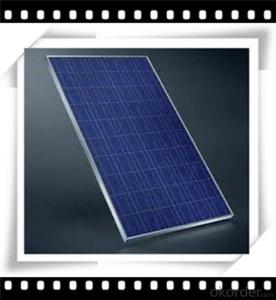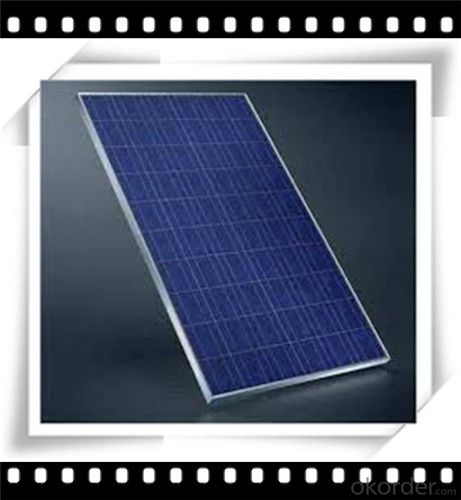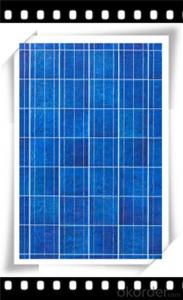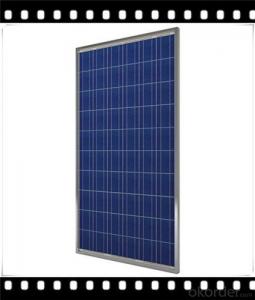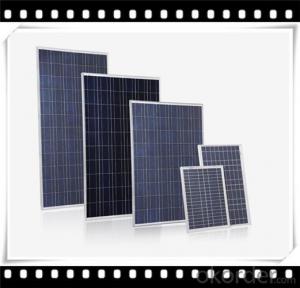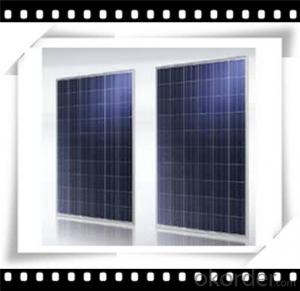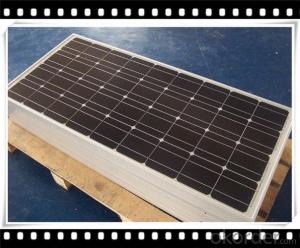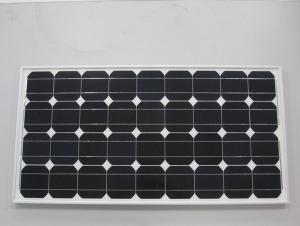245w Poly Solar Panel Medium - Solar Panels for Apartment Balcony - Hot Selling CNBM Solar Panel
- Loading Port:
- Qingdao
- Payment Terms:
- TT OR LC
- Min Order Qty:
- 10 set
- Supply Capability:
- 300000 set/month
OKorder Service Pledge
OKorder Financial Service
You Might Also Like
Polycrystalline Solar Modules
CNBM offers a range of small, medium and large polycrystalline solar modules, designed for a range of requirements.
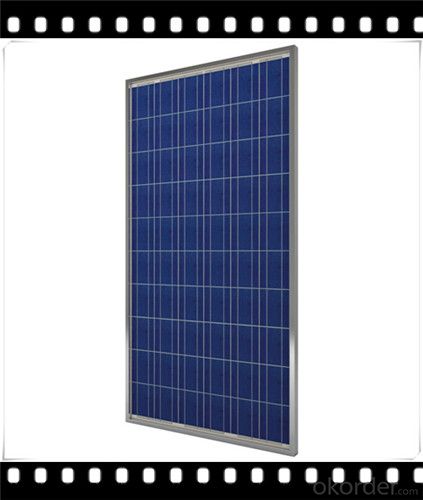
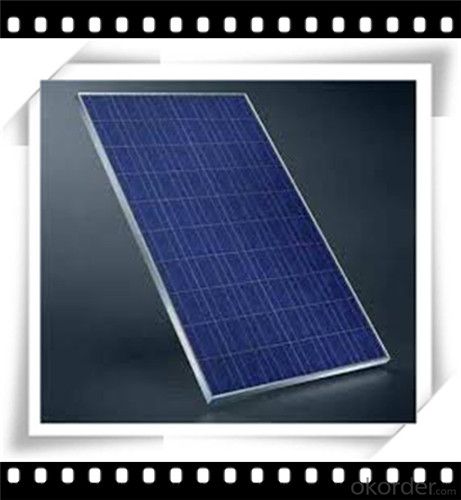
Specifications:
+/-3% |
Polycrystalline silicon solar cells (156 x 156mm) |
60 (10 x 6) |
1650 x 990 x 40 |
25.5 |
Limits:
Operating Temperature | -40~+85? |
Storage Temperature | -40~+85? |
Maximum System Voltage | 1000 VDC max. |
Hail Impact | Diameter of 28mm with impact speed |
Temperature and Coefficients:
NOCT | 48C+/-2? |
Voltage temperature coefficient (%/K) | -0.35 |
Current temperature coefficient (%/K) | 0.05 |
Power temperature coefficient (%/K) | -0.45 |
Characteristics:
Model: | SGM-200P | SGM-210P | SGM-220P |
Max-power voltage Vmp (V) | 29.2 | 29.4 | 29.41 |
Max-power current Imp (A) | 6.85 | 7.14 | 7.48 |
Open-circuit voltage Voc (V) | 36.5 | 36.69 | 36.9 |
Short-Circuit Current Isc (A) | 7.28 | 7.6 | 7.93 |
Max-power Pm(W) | 200 | 210 | 220 |
Model: | SGM-230P |
Max-power voltage Vmp (V) | 29.8 |
Max-power current Imp (A) | 7.72 |
Open-circuit voltage Voc (V) | 37.31 |
Short-Circuit Current Isc (A) | 8.19 |
Max-power Pm(W) | 230 |
STC: Irradiance 1000W/m2, module temperature 25?, AM-=1.5
Poly Crystalline Solar Panels Specifications Range
Maximum Power (Pm) | Dimension | Weight | Operating Voltage (Vmp) | Operating Current (Imp) | Open Circuit Voltage (Voc) | Short Circuit Current (Isc) |
0.45W | 140x80x10mm | 0.08kg | 3.3V | 150mA | 4.6V | 160mA |
1.0W | 162x140x10mm | 0.16kg | 7.5V | 150mA | 10.3V | 160mA |
4.5W | 269x251x23mm | 0.8kg | 16.5V | 0.27A | 20.5V | 0.3A |
10W | 420.1×268.9×22.6mm | 1.92kg | 17.5V | 0.58A | 20.5V | 0.6A |
20W | 425x502x50mm | 3.0kg | 16.8V | 1.19A | 21.0V | 1.29A |
30W | 593x502x22.6mm | 3.9kg | 16.8V | 1.78A | 21.0V | 1.94A |
40W | 655x537x50mm | 5.75kg | 17.3V | 2.31A | 22.1V | 2.54A |
50W | 839x537x50mm | 6.0kg | 17.5V | 2.9A | 21.8V | 3.17A |
65W | 1111x502x50mm | 7.2kg | 17.6V | 3.69A | 22.1V | 3.99A |
80W | 1204x537x50mm | 7.7kg | 17.6V | 4.55A | 22.1V | 4.8A |
- Q: Can solar panels be installed on windows?
- Yes, solar panels can be installed on windows. There are specialized solar window films and transparent solar panels available that can be affixed to windows, allowing them to generate electricity from sunlight while still maintaining visibility. These innovative technologies enable solar energy harvesting even in urban environments with limited roof space.
- Q: Are there any fire risks associated with solar panels?
- Yes, there are fire risks associated with solar panels, although they are relatively rare. The main risk factors include faulty installation, damaged wiring, and electrical malfunctions. However, adherence to proper installation standards, regular maintenance, and the use of high-quality equipment significantly mitigate these risks.
- Q: Can solar panels be used for powering outdoor lighting?
- Yes, solar panels can be used to power outdoor lighting. Solar panels absorb sunlight and convert it into electricity that can be stored in batteries. This stored energy can then be used to power outdoor lights, making them a sustainable and cost-effective option for outdoor lighting.
- Q: Can solar panels be installed on a recreational vehicle (RV)?
- Yes, solar panels can be installed on a recreational vehicle (RV). Installing solar panels on an RV allows for the generation of electricity from sunlight, providing a renewable and independent power source while on the go. This is particularly useful for boondocking or camping in remote locations where access to traditional power sources may be limited.
- Q: Can solar panels be installed on public transportation systems?
- Yes, solar panels can be installed on public transportation systems. In fact, many cities around the world are increasingly integrating solar panels onto buses, trams, and trains to harness clean energy and reduce carbon emissions. These panels can be installed on the roofs or sides of vehicles, enabling them to generate electricity and contribute to the power needs of the transportation systems.
- Q: How can I know the right type of solar panel to choose for my small village house in Africa?
- The power output of a solar panel uses a formula to determine kilowatts produced per hour per square meter per day. This calculation is important because, if you plan to install a solar power system for your home, you will want to know how many solar panels will be needed. To calculate solar power requirements correctly, you need to gather the data that is needed for the calculation. First you have to find the average amount of solar radiation available for your area. You can use a solar radiation chart. This can range from a 4 to a 7 depending on the area you live in. Write the number down on a piece of paper and indicate it with the letters RA. Next is determine the amount of electricity that you use daily. Add the kilowatt-hours used per month from your utility bill. Multiply this number by ,000 to get the watt hours in a month. Divide the total by 30 for the amount of electricity you use daily. Write this number down and indicate it with the letters DE. Determine the percentage of your home that you want to power with the solar power system. Write this number down and indicate it with the letter P. Determine the system inefficiency factor for the solar power system. You should be able to find this on the brochure for the system or from the manufacturer's web site. Write this number down and indicate it by the letter I. Determine the power or yield that is required for your home. Use the equation P = I x (DE x P) / RA to find the power requirements in kWh. Divide the number from Step 5 by the peak wattage for a single solar panel to determine the number of panels you will need for your home. Goodluck! :)
- Q: how big of an solar panel do i need to power/charge my laptop?would one from canadian tire sell the right one?
- Yes. Basically, here's what you need (I'm keeping this general on purpose): The panels themselves -- how large an area depends on average power consumption and how much power you can get on average. That, in turn , depends on climate. You'd need more in Seattle than Tuscon, for example. I'd guess something in the neighborhod of 0 square feet. Depends also on haow many gadgets (printers, etc.) you have. You'll need a power storage system. Lithium gives you the best poser density (of off-the-shelf stuff) but an ordinary car battery works well and is reliable. And, of course, a control system to manage the power generation/storage/use so everything works together without that annoying smell that tells you you just cooked a few hundred bucks worth of equuipment! :)
- Q: First of all is it possible? I do not know how much electricity my dehumidifier but could someone give me an idea of how much this would cost to do? A link to a solar panel or equipment that would do the job would be nice too.Thanks in advance.
- Great! The general steps are: . Determine how much power your humidifier uses (watts). Multiply the amperage x 5 (Assuming you're in the U.S.) 2. Determine what size solar panel you need (this will be in watts as well). Consider that the rating for a solar panel is optimal. That means that's the best it will be in direct sunlight. 3. Determine if you want a battery in the system. A battery will store energy from the solar panel so you can use it later. Helps for cloudy days or when the panel otherwise doesn't output the same power as the humidifier uses. 4. Figure out the right charge controller. You need to regulate the power from the solar panel into either the humidifier or the battery setup. 5. Tie it all in together, using proper electrical connections. It can be complicated, but its certainly a good feeling to get power from the sun. Good luck!
- Q: Can solar panels be installed on a restaurant or food service establishment?
- Yes, solar panels can be installed on a restaurant or food service establishment. Installing solar panels can help offset energy costs and reduce the carbon footprint of the establishment, making it a more sustainable and environmentally-friendly choice.
Send your message to us
245w Poly Solar Panel Medium - Solar Panels for Apartment Balcony - Hot Selling CNBM Solar Panel
- Loading Port:
- Qingdao
- Payment Terms:
- TT OR LC
- Min Order Qty:
- 10 set
- Supply Capability:
- 300000 set/month
OKorder Service Pledge
OKorder Financial Service
Similar products
Hot products
Hot Searches
